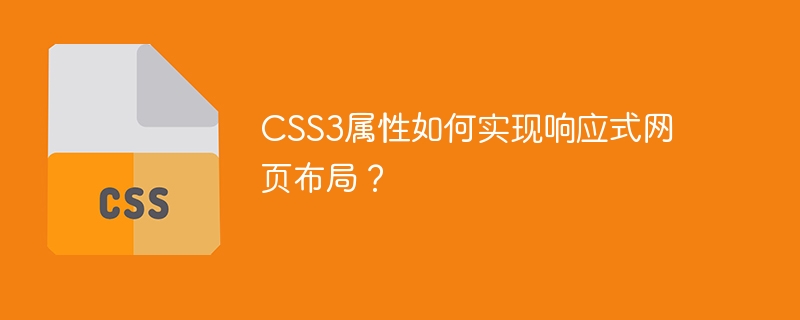

How do CSS3 properties implement responsive web page layout?
With the popularity of mobile devices and the rapid development of the Internet, responsive web design has become a trend in modern web design. Using responsive web design allows web pages to be presented with the best display effects on different devices. CSS3 properties play a crucial role in implementing responsive web page layout. The following will introduce some commonly used CSS3 properties and their application in responsive web layout.
@media query is one of the keys in CSS used to set different styles for different devices and media types, such as screens and printers. By using @media queries, you can provide different styles for different devices based on conditions such as the device's width, height, and screen orientation.
For example, you can add different styles for devices with a screen width less than 600px through the following code example:
@media screen and (max-width: 600px) { /* 在屏幕宽度小于600px时应用的样式 */ body { font-size: 14px; background-color: lightblue; } }
In this example, the font size of the body element when the screen width is less than 600px will become 14px, and the background color will change to light blue.
By using @media query, you can provide different layouts and styles according to different device sizes and orientations to achieve responsive web page layout.
Flexbox layout is a powerful layout method in CSS3, which is suitable for devices of various sizes and orientations. Using flexbox layout, you can easily achieve vertical centering, equal height columns, adaptive layout and other effects.
The following is an example of using flexbox layout to implement a vertically centered container:
这是一个垂直居中的容器
.container { display: flex; align-items: center; justify-content: center; height: 300px; background-color: lightgray; } .content { text-align: center; font-size: 24px; }
In this example, by setting the display: flex attribute to the parent container, and then using align-items and justify-content attributes center the content vertically and horizontally. This allows for vertical centering of the container regardless of the device's size and orientation.
Grid layout is another powerful layout method in CSS3. It can divide the page into rows and columns and define grid cells. layout and size to achieve complex web page layout effects.
The following is an example of using grid layout to implement a simple grid layout:
123
.container { display: grid; grid-template-columns: repeat(3, 1fr); grid-gap: 10px; } .item { background-color: lightblue; padding: 20px; text-align: center; }
In this example, by setting the display: grid attribute to the parent container, and using grid- The template-columns property defines the number and size of the grid's columns, and then the grid-gap property defines the spacing between grid cells. This way, the page will be divided evenly into 3 columns, with 10px space between each grid cell.
By using grid layout, complex web page layouts can be flexibly implemented to adapt to the requirements of different devices and screen sizes.
In addition to the several CSS3 properties mentioned above, there are many other CSS3 properties that can be used to implement responsive web page layout, such as flexbox's elastic scaling and expansion, as well as images and media queries, etc.
In short, by using CSS3 properties, we can easily implement responsive web page layout so that the web page can adapt to the requirements of different devices and screen sizes. Not only can it improve the user experience, but it can also improve the accessibility and maintainability of the website. Therefore, when designing and developing web pages, we should make full use of various properties of CSS3 and use them flexibly to achieve the goal of responsive web layout.
The above is the detailed content of How do CSS3 properties implement responsive web layout?. For more information, please follow other related articles on the PHP Chinese website!
 Usage of between function
Usage of between function Complete list of CSS color codes
Complete list of CSS color codes What are the differences between linux and windows
What are the differences between linux and windows Use of jQuery hover() method
Use of jQuery hover() method Where should I fill in my place of birth: province, city or county?
Where should I fill in my place of birth: province, city or county? Solution to javascript:;
Solution to javascript:; Is the success rate of railway 12306 standby ticket high?
Is the success rate of railway 12306 standby ticket high? array_push
array_push



